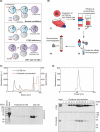Enzyme replacement therapy with recombinant pro-CTSD (cathepsin D) corrects defective proteolysis and autophagy in neuronal ceroid lipofuscinosis
- PMID: 31282275
- PMCID: PMC7158922
- DOI: 10.1080/15548627.2019.1637200
Enzyme replacement therapy with recombinant pro-CTSD (cathepsin D) corrects defective proteolysis and autophagy in neuronal ceroid lipofuscinosis
Abstract
CTSD (cathepsin D) is one of the major lysosomal proteases indispensable for the maintenance of cellular proteostasis by turning over substrates of endocytosis, phagocytosis and autophagy. Consequently, CTSD deficiency leads to a strong impairment of the lysosomal-autophagy machinery. In mice and humans CTSD dysfunction underlies the congenital variant (CLN10) of neuronal ceroid lipofuscinosis (NCL). NCLs are distinct lysosomal storage disorders (LSDs) sharing various hallmarks, namely accumulation of protein aggregates and ceroid lipofuscin leading to neurodegeneration and blindness. The most established and clinically approved approach to treat LSDs is enzyme replacement therapy (ERT) aiming to replace the defective hydrolase with an exogenously applied recombinant protein. Here we reveal that recombinant human pro-CTSD produced in a mammalian expression system can be efficiently taken up by a variety of cell models, is correctly targeted to lysosomes and processed to the active mature form of the protease. In proof-of-principle experiments we provide evidence that recombinant human CTSD (rhCTSD) can improve the biochemical phenotype of CTSD-deficient hippocampal slice cultures in vitro and retinal cells in vivo. Furthermore, we demonstrate that dosing of rhCTSD in the murine CLN10 model leads to a correction of lysosomal hypertrophy, storage accumulation and impaired autophagic flux in the viscera and central nervous system (CNS). We establish that direct delivery of the recombinant protease to the CNS is required for improvement of neuropathology and lifespan extension. Together these data support the continuation of the pre-clinical studies for the application of rhCTSD in the treatment of NCL.Abbreviations: AIF1/IBA1: allograft inflammatory factor 1; BBB: blood brain barrier; CNS: central nervous system; CTSB: cathepsin B; CTSD: cathepsin D; CTSL: cathepsin L; ERT: enzyme replacement therapy; GFAP: glial fibrillary acidic protein; INL: inner nuclear layer; LAMP1: lysosomal-associated membrane protein 1; LAMP2: lysosomal-associated membrane protein 2; MAP1LC3/LC3: microtubule-associated protein 1 light chain 3; LDL: low-density lipoprotein; LRP1: low density lipoprotein receptor-related protein 1; LSD: lysosomal storage disorder; MEFs: mouse embryonic fibroblasts; M6P: mannose 6-phosphate; mCTSD: mature CTSD; NCL: neuronal ceroid lipofuscinosis; ONL: outer nuclear layer; PB: phosphate buffer; proCTSD: pro-cathepsin D; LRPAP1: low density lipoprotein receptor-related protein associated protein 1; rhCTSD: human recombinant CTSD; SAPC: saposin C; SAPD: saposin D; ATP5G1: ATP synthase, H+ transporting, mitochondrial F0 complex, subunit C1 (subunit 9); SQSTM1/p62: sequestosome 1; TPP1: tripeptidyl peptidase I.
Keywords: Autophagy; cathepsin D; enzyme replacement therapy; lysosome; neuronal ceroid lipofuscinosis; proteolysis; storage; therapy.
Figures






Similar articles
-
Recombinant pro-CTSD (cathepsin D) enhances SNCA/α-Synuclein degradation in α-Synucleinopathy models.Autophagy. 2022 May;18(5):1127-1151. doi: 10.1080/15548627.2022.2045534. Epub 2022 Apr 28. Autophagy. 2022. PMID: 35287553 Free PMC article.
-
Analysis of cathepsin B and cathepsin L treatment to clear toxic lysosomal protein aggregates in neuronal ceroid lipofuscinosis.Biochim Biophys Acta Mol Basis Dis. 2021 Oct 1;1867(10):166205. doi: 10.1016/j.bbadis.2021.166205. Epub 2021 Jun 30. Biochim Biophys Acta Mol Basis Dis. 2021. PMID: 34214607
-
Intravitreal gene therapy restores the autophagy-lysosomal pathway and attenuates retinal degeneration in cathepsin D-deficient mice.Neurobiol Dis. 2022 Mar;164:105628. doi: 10.1016/j.nbd.2022.105628. Epub 2022 Jan 13. Neurobiol Dis. 2022. PMID: 35033660
-
The intracellular location and function of proteins of neuronal ceroid lipofuscinoses.Brain Pathol. 2004 Jan;14(1):77-85. doi: 10.1111/j.1750-3639.2004.tb00501.x. Brain Pathol. 2004. PMID: 14997940 Free PMC article. Review.
-
Interactions of the proteins of neuronal ceroid lipofuscinosis: clues to function.Cell Mol Life Sci. 2011 Feb;68(3):453-74. doi: 10.1007/s00018-010-0468-6. Epub 2010 Aug 1. Cell Mol Life Sci. 2011. PMID: 20680390 Free PMC article. Review.
Cited by
-
Plasma Small Extracellular Vesicle Cathepsin D Dysregulation in GRN/C9orf72 and Sporadic Frontotemporal Lobar Degeneration.Int J Mol Sci. 2022 Sep 14;23(18):10693. doi: 10.3390/ijms231810693. Int J Mol Sci. 2022. PMID: 36142612 Free PMC article.
-
Lysosomal cathepsin D mediates endogenous mucin glycodomain catabolism in mammals.Proc Natl Acad Sci U S A. 2022 Sep 27;119(39):e2117105119. doi: 10.1073/pnas.2117105119. Epub 2022 Sep 19. Proc Natl Acad Sci U S A. 2022. PMID: 36122205 Free PMC article.
-
Experimental Therapeutic Approaches for the Treatment of Retinal Pathology in Neuronal Ceroid Lipofuscinoses.Front Neurol. 2022 Apr 18;13:866983. doi: 10.3389/fneur.2022.866983. eCollection 2022. Front Neurol. 2022. PMID: 35509995 Free PMC article. Review.
-
Targeting lysosomes in human disease: from basic research to clinical applications.Signal Transduct Target Ther. 2021 Nov 8;6(1):379. doi: 10.1038/s41392-021-00778-y. Signal Transduct Target Ther. 2021. PMID: 34744168 Free PMC article. Review.
-
APY0201 Represses Tumor Growth through Inhibiting Autophagy in Gastric Cancer Cells.J Oncol. 2022 Jun 24;2022:7104592. doi: 10.1155/2022/7104592. eCollection 2022. J Oncol. 2022. PMID: 36245991 Free PMC article.
References
-
- Vidoni C, Follo C, Savino M, et al. The Role of Cathepsin D in the Pathogenesis of Human Neurodegenerative Disorders. Med Res Rev. 2016;36:845–870. - PubMed
-
- Markmann S, Thelen M, Cornils K, et al. Lrp1/LDL Receptor Play Critical Roles in Mannose 6-Phosphate-Independent Lysosomal Enzyme Targeting. Traffic. 2015;16:743–759. - PubMed
Publication types
MeSH terms
Substances
LinkOut - more resources
Full Text Sources
Other Literature Sources
Molecular Biology Databases
Research Materials
Miscellaneous
